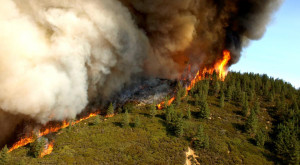Fire & the Environment
Wildfires do more than threaten lives and destroy properties, they also affect our health, amenities, and threaten our natural resources such as water, air, wildlife, and our natural habitat.
The warmer temperatures and reductions in rainfall that we are currently experiencing lead to very low moisture levels in the vegetation surrounding our communities; particularly those in the Wildland Urban Interface (WUI). Drier vegetation coupled with prolonged drought could increase the severity and frequency of wildfires. Fires could contribute to climate change, through the release of carbon dioxide with vegetation burns, and this impact could worsen if the number and scale of wildfires increases.
Across the Western United States, wildfires have become more frequent and the fire season has become longer. It is imperative that San Diego County residents, particularly those in the WUI, are prepared for dealing with wildfire; because it is not a matter of if, but when.
Here are some resources that discuss the links between wildfire and climate change:
 Forest Stewardship Series 25: Adapting Forests to Climate Change: This publication can help owners of California forest land better understand the evolving science of climate change, the possible effects these changes will have on forests, and the actions they can take to better adapt their forests to the climate of the future: future.http://anrcatalog.ucanr.edu/pdf/8574.pdf
Forest Stewardship Series 25: Adapting Forests to Climate Change: This publication can help owners of California forest land better understand the evolving science of climate change, the possible effects these changes will have on forests, and the actions they can take to better adapt their forests to the climate of the future: future.http://anrcatalog.ucanr.edu/pdf/8574.pdf
Western Wildfires & Climate Change: An infographic illustrating the impact climate change is having on wildfire risk, both historically and with an eye to the future:
http://www.ucsusa.org/global_warming/science_and_impacts/impacts/infographic-wildfires-climate-change.html#.VqpK5PkrKUk
Wake Up Call for the Western United States: this National Wildlife Federation report investigates how global warming increases wildfire threat: https://www.nwf.org/Wildlife/Threats-to-Wildlife/Global-Warming/Global-Warming-is-Causing-Extreme-Weather/Wildfires.aspx
Climate Change Indicators in the United States: this tool from the Environmental Protection Agency (EPA) tracks the frequency, amount of land burned, and severity of wildfires in the United States: http://www3.epa.gov/climatechange/science/indicators/ecosystems/wildfires.html
San Diego, 2050 Is Calling, How Will We Answer?: Community leaders and scientists are collaborating to address climate changes affecting our temperate climate, resources, natural areas, and regional economy. This report outlines the substantial impact that rising temperatures, drier soils and vegetation, and less frequent but more intense rainfall could have on San Diego County: http://www.sandiego.edu/2050/
Tree Mortality Crisis: Due to the deadly combination of drought and bark beetles, California is experiencing a tree mortality crisis. Weakened by four consecutive years of drought, over 29 million conifers and hardwood trees have succumbed to bark beetle attacks, and died: http://www.fs.usda.gov/CATreeMortality
